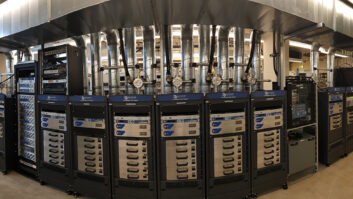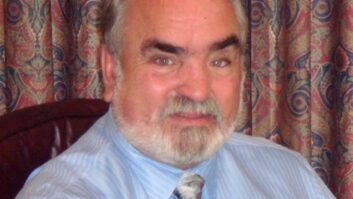Trends in Technology: Audio Storage and Delivery Systems
Nov 1, 2001 12:00 PM, By Barry Thomas, CSRE CBNT

It’s gotten to the point where I’m horrified to see a cart machine in use at a radio station. Just about every feature we have appreciated in the broadcast cartridge has been replaced by a more flexible and better-sounding alternative. The economics are such that a digital delivery system is not only preferred but is necessary for the efficient operation of a radio station.
The most important function of a standard digital audio delivery system is spot and music playback. Systems built around this function are typically the centerpiece of modern studio operations. Most systems offer options or features to accommodate on-the-fly playback of elements like beds, jingles, bits, etc., but most are designed to simplify the core studio operation and offer greater reliability. Each system is unique and is adjusted to match a station’s specific needs and the talent’s requirements. For this reason, there are no solutions that would apply everywhere. System design, installation, and execution depends on the expertise of people who know the operation to select the appropriate system and adapt tools and modules available in a given brand of system. As the station engineering manager, you are in the most unique position to perform these tasks and release the potential of new technology.
Recent developments in audio and data delivery have put pressure on suppliers of delivery systems to expand their options and interconnectivity to accommodate audio streaming, spot insertion, and interactivity. Many systems offer control and voice tracking from remote locations like affiliated stations or remote broadcast sites. Most companies now offer, or are working on, solutions for these issues and much more.
It’s fortunate that there is a wide variety of choices available with a wide range of features and price points. You should be able to find everything you need for your station through these companies and even discover new ways to make your life easier. The list of systems outlined here is comprehensive but not complete. You should contact the manufacturers or your broadcast equipment supplier for more information.
Enco
www.enco.com
DADPro
Audio Hardware
: Antex, Digigram, Soundblaster
OS: MS Windows 98/NT
Network OS/Protocol: MS TCP/IP
DADPro uses a workstation platform with a variety of on-screen windows that can be tailored for users’ needs. Player windows allow live assist or fully automated modes and transparent transition between modes, with support of crossfaded or overlapped segue transitions, voice tracks, and automatic spot rotations. Some of the players can be user-customized cart walls or instant-play hot buttons. The recorder windows can be used for automatic phone recording, editing and automated/unattended network feed acquisition. The system can use the Orban AirTime Brick control surfaces. Control of external gear is achieved using serial communications or a GPI interface. Enco provides graphic two-track waveform editing and a separate multichannel editor. File import from popular editing software is supported.
MediaTouch
www.imediatouch.com
iMediaTouch
Audio Hardware
: Antex, Standard Pro Audio Cards, Soundblaster
OS: MS Windows NT/2000
Network OS/Protocol: MS TCP/IP
The company’s products are designed to allow remote operation of automation system from remote and/or multiple locations. MediaTouch software programs have codecs by QDesign (MP2), Fraunhoffer (MP3), Microsoft (ADPCM & Windows WMA) and PCM. All formats can be played in overlaps simultaneously, regardless of audio card capability. MediaTouch touch-screen interfaces are designed to reduce or eliminate the mouse pointer table chase and increase the speed and efficiency of live-assist operations.
Arrakis
www.arrakis-systems.com
Digilink Free
Digilink DL4-MAX
Audio Hardware
: Any Windows-compliant hardware
OS: MS Windows 98/NT/2000/ME
Digilink Free is suited for stations using automation for fully automated and live-assist operation. The DL4-Max system is based on the DL4-Max engine, a self-contained on-air and production system with 210 hours of audio storage. Networking is not supported. Stations must supply one Windows PC for production and one PC for on-air.
Prophet Systems
www.prophetsys.com
NexGen
Audio Hardware: Proprietary
OS: Microsoft Windows NT/2000
Network OS/Protocol: MS TCP/IP
Prophet has a long history of offering automation systems. NexGen is designed to offer extensive tools for companies who are consolidating operations and voice tracking or fully-automating their stations. Prophet’s WAN-casting system allows stations to share and use system data and audio between interconnected sites.
Broadcast Electronics
www.audiovault.com
Vault2/VaultXpress
Audio Hardware
: Standard Pro Audio Cards, SoundBlaster
OS: Windows NT, 2000
Network OS/Protocol: Microsoft Netbui/TCP/IP
Broadcast Electronics offers and supports the original AudioVault systems, updated to support Windows 2000. In Vault2 and VaultXpress, Broadcast Electronics employs the AVAir and AVRecord user interfaces but has replaced the AV100 cards with industry-standard audio cards including the SoundBlaster.
Broadcast Software International
www.bsiusa.com
Simian Automation, Wavecart Digital Cart Replacement, WebconnectPro System remote control and notification, Stinger Instant Audioplayer
Audio Hardware
: Audioscience, SoundBlaster
OS: MS Windows 95, 98, NT, 2000
Network OS/Protocol: Microsoft TCP/IP
BSI offers Stinger, an automation and cart replacement/instant audio product. Companion products use standard PC hardware and the Audioscience audio adapters. The Simian automation system manages satellite operation playback, live assist and background recording.
Computer Concepts Corporation
www.ccc-dcs.com
Maestro
Audio Hardware
: Audioscience, Digigram, Standard Pro Audio Cards
OS: MS Windows NT
Network OS: Novell
The Computer Concepts system is designed to work directly with the company’s Visual Traffic system but can interface with scheduling and traffic with minor effort.
Smarts Broadcast
www.smartsbroadcast.com
www.onairusa.com
Smartcaster
RadioSuite HD
Operating System
: DOS/Windows/Linux
Network OS: TCP/IP or LANTastic
The Smartcaster digital audio system is designed to interface with the Smarts traffic and billing system and the Smarts Digital Program Director (DPD) music scheduling system. The critical parts of the Smartcaster system are based on DOS, but system control and the user interfaces are Windows-based. Smarts has purchased On Air Digital, which offers a Linux-Base digital audio system. The On Air Digital RadioSuite HD system has been successful in use by stations running music or live-assist formats.
RCS
www.rcsworks.com
Master Control
Audio Hardware
: Digigram
OS: Windows 2000
Network OS/Protocol: TCP/IP
RCS Master Control now features Internet Voice Tracking, a patented process allowing talent to run shows from any location over the Web. Also, Real Feel studio Voice Tracks, a Log-Linked Web Browser, dayparted Hot Keys and the Living Log with direct access to/from Selector Music Scheduling are all standard in Master Control.
Netia Digital Audio
www.netia.fr
Radio-Assist 7
Audio Hardware
: Digigram
OS: Microsoft Windows NT
Network OS/Protocol: MS TCP/IP
The system can interface to ENPS, the Associated Press’ news processing system. It is now possible to associate audio and text for editing on a single screen with database links. The system’s latest software offers many possibilities for console integration through the use of highly configurable GPI I/Os. Relay orders with applications for multicasting, can be inserted.
Dalet Digital Media Systems USA
www.dalet.com
DaletPlus
Audio Hardware
: Antex
OS: MS Windows
Network OS/Protocol: MS TCP/IP
Dalet’s system supports a multimedia environment. The Multimedia scheduler provides scheduling capability for radio and associated media. Dalet holds to a �produce once, broadcast many� approach, allowing the company’s radio broadcast system to integrate with its audio production, digital content management, news and playback systems.
Cartworks/dbm Systems
www.cartworks.com
CartWorks
Audio Hardware
: Audioscience
OS: MS Windows 98/2000 Pro
Network OS/Protocol: MS TCP/IP
Cartworks uses individual PC workstations for live assist, voice tracking and satellite automation. Audio from home computers, professional digital audio workstations, the Internet or most any source can be played without conversion. The system supports Standard Microsoft WAV, MPEG, and other digital audio formats.
IBM/Jutel Oy
www.jutel.fi
RadioMan
Audio Hardware
: Digigram/IBM
OS: UNIX/MS Windows NT
Network OS/Protocol: IBM TCP/IP
RadioMan is designed for collaborative operation. Multiple station departments can be working with files simultaneously. RadioMan is designed to be a complete automation solution and encompasses a vast array of products for scheduling, editing, Internet and digital broadcasting, data transmission, and file management.
LPB
www.lpbinc.com
WebJockey
Salsa (DOS & Windows)
Audio Hardware
: Standard Pro Audio Cards, Soundblaster
OS: MS Windows 98
LPB’s Webjockey is designed as a cart replacement solution for stations with limited budgets, webcasters or LPFM operators and supports MP3 and WAV file playback, includes a 36-key instant player, and offers on-air, next and played LED indicators, on-screen faders, and individual muting for each channel. Salsa, a larger-scale automation system, offers GPI controls, event scheduling, news and traffic as available options.
Scott Studios
www.scottstudios.com
SS32
Audio Hardware
: Audioscience
OS: MS Windows 2000
Network OS/Protocol: MS TCP/IP
The SS32 products offer configurable user interfaces designed by DJs. Voice tracking, newsroom software and a phone call recorder are available. The system is designed to integrate with such production software as Audicy, Sound Forge and CoolEdit. Audio cuts can be accessed using a cart wall screen, which is accessible remotely. Scott integrates with many traffic and music software systems and offers methods for Internet ad substitution that work with its on-air systems.
Register Data Systems
www.registerdata.com
The Phantom
Audio Hardware
: AudioScience, Antex
OS: DOS
Network OS/Protocol: Snap Server
Based on an open system architecture, the Phantom can record audio feeds while playing back and switch to external feeds. Information is displayed concisely with pull-down menus to guide users. Schedules can be loaded for times years in the future. Audio files can be retimed to fit set windows.
Barry Thomas is chief technology officer of Stratos Audio Inc. and a contract engineer in the Los Angeles area.












